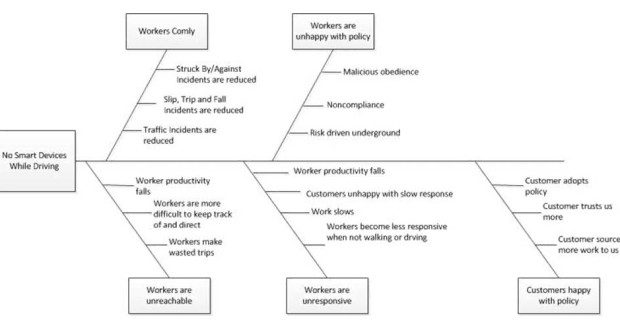Safety in the Digital Age: Regulating Worker Use of Distracting Devices
The dangers of distraction while working have garnered a great deal of attention. Distraction increases the risk of injury, but taking the appropriate steps to reduce distraction are neither easy nor simple. Much thought must be given to the consequences, fairness, and practicality of any regulations aimed at reducing the risks associated with worker distraction.
Posted: January 23, 2014
May Act As A Catalyst For Other Injuries
Another by-product of distraction is human error (undeliberate, inadvertant actions with undesirable outcomes). Studies show that distraction significantly increases the chances of committing a human error. In his book, Whack-a-Mole: The Price We Pay for Expecting Perfection, David Marx identifies what he calls “performance shaping behaviors,” or factors that tend to increase people’s tendency to make a human error. These include distraction. Clearly, to protect workers we msut reduce distraction overall, and distracting devices specifically.
The Myth Of Multitasking
Chabris and Simons have shown how the more incompetent a person tends to be, the more mistakenly confident they are in their abilities. Studies show that the higher the competency a person has, the greater the tendency for them to rank their skills lower than they actually are. It is no coincidence that the most widely over estimated skill is one’s ability to “multitask.”
Multitasking grew in popularity during the 1980s as people were pushed to do “more with less.” Individuals who appeared to be expert multitaskers were extolled for their prowess in business. The only problem is that, neurologically speaking, multitasking is a myth. The human brain is incapable of multitasking. Those who appear to possess superior multitasking abilities are in fact just people with strong short-term memory. The ability to quickly resume what was previously abandoned creates an illusion of multitasking, but it is just that: illusion.
DEFINING DISTRACTING DEVICES
Crafting a reasonably specific definition of what constitutes a distracting device is tricky. Attempting to define a distracting device as “anything that substantially interferes with an individual’s ability to focus on his or her job” isn’t practical, because no matter how comprehensive the list is of distracting devices, additional devices now enter the workplace so rapidly that an all-encompassing list is impossible to create and maintain. No device is intrinsically distracting. The dangers come from the myth of multitasking. So companies should instead focus on defining the dangers posed by the irresponsible use of devices, not the devices themselves.
CONSIDERATIONS FOR REGULATING DISTRACTIVE DEVICES
The two riskiest activities for a distracted person are walking and driving, two activities that intersect so frequently it is essential that any distraction policy address them. Some of the best policies center on activity. For example, when driving or walking, the following are not allowed while in motion or the vehicle is in gear:
- Talking on the telephone (including Bluetooth devices)
- Reading or sending email or text messages
- Using any mobile apps
Clearly Outline the Boundaries
In a recent study, one company found that over 70 percent of their employees admitted to violating the no cell phone use while driving. In this case and others like it, can a company really defend its policy as viable? If less than 30 percent of your workforce follows a policy, that policy must be overhauled. Compliance is not likely to increase simply because of the threat of greater disciplinary action.
Rethink Your Expectations For Connectivity and Responsiveness
One primary consideration in regulating distracted behavior is the effect restrictions will have on worker responsiveness. Many organizations talk about the need for safety, but when workers make the choice between behaving safely and not answering phones or emails while driving, the organization refuses to acknowledge the mutually exclusive nature of the situation. Restrictions on ancillary activities while walking or driving requires preparation for a significant drop in productivity and responsiveness.
Without recalibration of expectations for connectivity and responsiveness – that is, if work norms are not adjusted to allow for slower communication and significantly reduced responsiveness –the noncompliance will likely be driven underground. It is extremely difficult to force compliance among people who have little or no supervision or oversight of their day-to-day activity. An employee driving alone has very little oversight; compliance becomes almost exclusively voluntary.
Unless tragedy strikes or the individual is ticketed, it is highly likely that any noncompliance will go unnoticed and unaddressed. Emails awaiting a response, phone calls, text messages, or potentially urgent voicemails provide compelling incentives for employees to violate the policy. Unless a more compelling reason is created that is relative to response time, workers will cheat and you have abetted their violations.
Allow for Judgement In Extraordinary Circumstances
Whatever policy is crafted should clearly outline any extraordinary situations where it is advisable to actually violate the rule. If, for example, a worker is running for his life because of an attack or catastrophic event, they shouldn’t be expected to wait, find a safe place to stop and phone for help. Or maybe they should. In either case, clearly outline cases where noncompliance is allowed and make those clear.
Balance the Greater Danger(s)
As with any regulation, restrictions you place on distraction can have unintended consequences and may even lead to greater risk. Before implementing your policy, seek input from those affected to see if they can identify greater risks in not engaging in the activity than in doing it. I like to use the backward fish diagram that starts with a decision and tracks the potential outcomes (see Figure 1).
This simple diagram shows some of the potential outcomes of an out-and-out ban on smart devices while driving. This is just an example, but it illustrates the usefulness of the device. The “root” is the decision that has been made, in this example the decision to ban smart devices while driving. The “stem” boxes represent potential outcomes (they need not be probable or likely, just possible) and the “branch” boxes represent the outcomes of the stems.
Our example demonstrates three layers, but depending on the complexity of the root you could continue to branch out several or even many more levels. To get the best results, involve several stakeholders and employ the rules of brainstorming. The point of using this tool is to visually identify as many potential consequences of your policy as possible.
There are many good reasons for crafting policies for reducing distraction but, in the end, workers must exercise significant self-discipline in maintaining the appropriate levels of focus.













